Choosing a phytolamp for seedlings
Phytolamps make it easier to care for seedlings during short daylight hours. Young seedlings are illuminated, otherwise it will not be possible to get strong, healthy plants. For some potted crops, appliances are turned on almost all year round. Therefore, choosing the right device is a responsible task. Consider which phytolamp is best for seedlings.
The content of the article
How does backlight affect seedlings
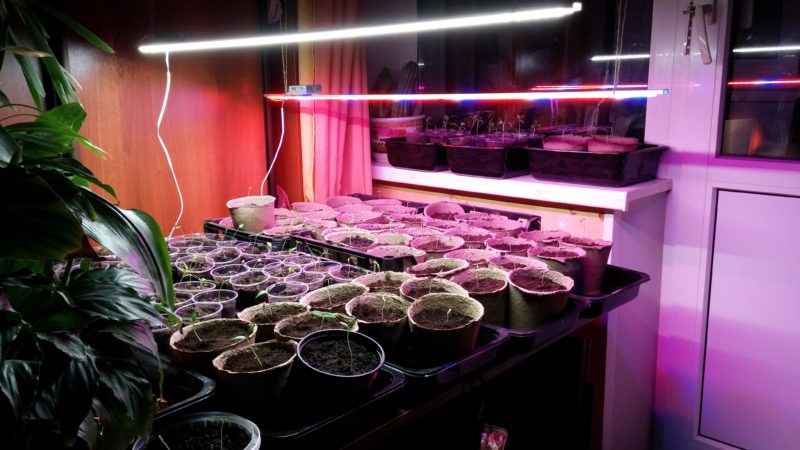
Light for plants is a source of full development. Only under its influence the process of photosynthesis takes place, which contributes to the correct formation of both the aerial parts of the plant and the root system.
The different parts of the spectrum have an impact on the seedlings. Red is required for seed germination and vertical development, flowering, fruit formation, without it, the sprout will be pale and twisted. When this part of the spectrum is absorbed for 10 minutes, the process of photosynthesis starts, the cotyledons turn green, the plant straightens out.
Reference. Before the first shoots, the illumination is carried out in the red spectrum, when shoots appear - in the mixed one, then in the blue.
Blue and purple colors contribute to an increase in green mass in the vegetative phase of growth, have an inhibitory effect on cell division, so the seedlings do not stretch, and the stem thickens.
Can I use incandescent bulbs

The biggest mistake when lighting plants is using conventional electric incandescent lamps. They give more than 90% of heat and only 5-6% of light. This negligible amount is of no benefit to plants because it does not meet the color spectrum requirements. Incandescent light bulbs only lead to burns, drying out of the topsoil and high electricity bills.
Requirements for additional lighting
For the formation of healthy seedlings, the main conditions are maintained - the time of additional illumination and the power of the luminous flux in relation to photosynthesis. The duration depends on the specific plants: some light more time, others less. The power of the lamp should not harm the sprouts: if it is intense, it is placed higher, if it is weak, lower.
Too powerful lamps installed at a height of 40-50 cm from the plants will work ineffectively, scattering light. Therefore, they are used with lampshades or visors, directing the entire luminous flux to boxes or pots with seedlings.
It is interesting:
How to properly plant and grow cabbage seedlings at home.
A beginner's guide to growing raspberries from seed for seedlings at home.
Types of phytolamps
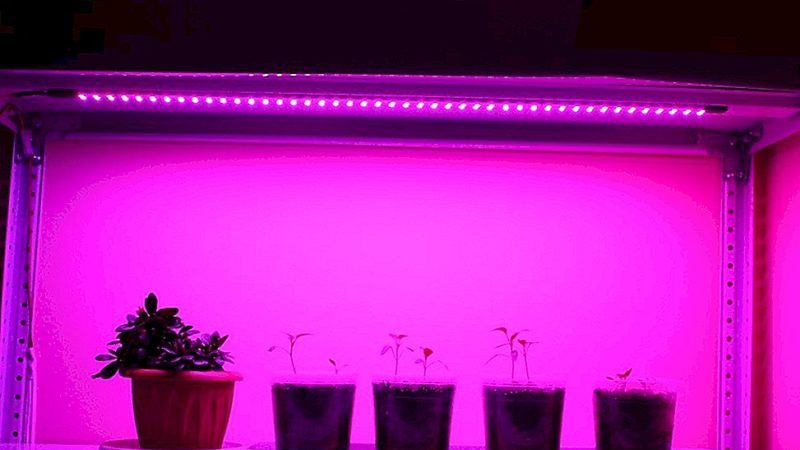
A wide range of light sources for plants is due to the latest advances in industry. Technologies allow you to choose a phytolamp based on efficiency, power consumption, service life.
The best devices according to the principle of operation:
- luminescent;
- induction;
- sodium;
- LED.
By the type of spectrum, phytolamps for seedlings are divided into bicolor, multispectral and full spectrum radiation.
Council. The seedlings are illuminated not only in the morning and in the evening, but also during the daytime, especially if the pots are on the western and northern windowsills.In winter and autumn, this is also done with plants on the southern and eastern sides.
Luminescent
In everyday life, such devices are called fluorescent lamps, because the spectrum emitted by them creates the illusion of sunlight. They have long been used by gardeners and flower growers. The devices do not burn plants, are economical and are produced in two tones - warm and cold. Warm ones are used to form a strong aboveground part of plants and during the flowering period, cold ones - for the full development of the root system.
Disadvantages of fluorescent lamps:
- short service life (on average 3500 hours);
- harmful effects on the retina, UV radiation;
- irritating influence of the blue spectrum;
- low power, which is why 2-3 lamps are used per window sill.
The average cost of one device is 500 rubles.
To give the plants more light, reflective foil screens are installed on the sides of the windows.
Energy saving
This type of fluorescent lamp allows you to use one device without much damage to your wallet for a long time. They cost more (700-800 rubles), but they serve up to 15,000 hours. The devices practically do not heat up, therefore they do not burn the plants.
Sodium biolamps
Such devices are used in large greenhouse complexes and with low power (from 70 W) - at home. They are expensive, require special conditions for switching on and off, observing the distance to the seedlings in order to exclude burns. They are actively used by agricultural enterprises in large greenhouse complexes to increase the yield of vegetable, green and flower crops.
The glow in the red spectrum is balanced for the plant, promotes flowering, fruit formation, safe and comfortable for the eyes. Arc sodium mirror lamps (DNaZ), optimal for seedlings, are equipped with a reflector that protects the plants from overheating. They have a high luminous efficiency (up to 150 lm / W), a service life of up to 25,000 hours and a luminous flux up to 30% higher than that of tubular lamps.
Reference. Some models require a special adapter.
The average cost of such a device is 1000-2000 rubles.
Induction
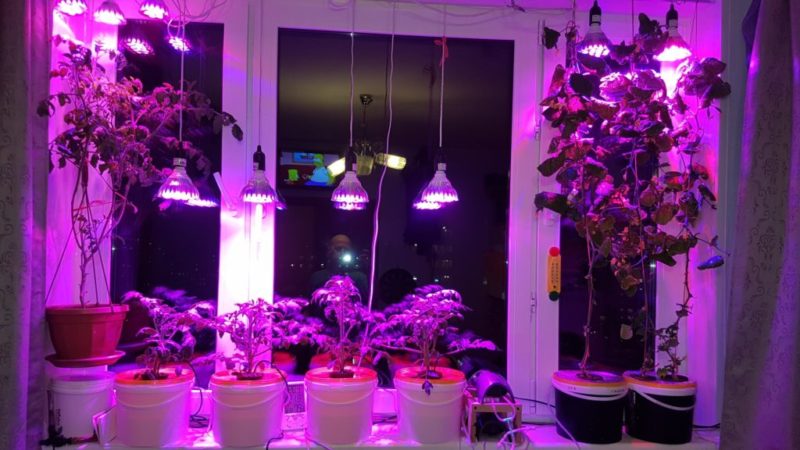
The principle of operation of such lamps is similar to fluorescent ones, only the spectrum is as close as possible to the sun. Such devices are durable and economical. The service life claimed by the manufacturers is up to 20 years with constant use. The bulb heats up slightly, so the lamp is installed close to the seedlings without the risk of burning it.
Bispectral models emit light in the red and blue ranges, which is convenient for illuminating plants, but not entirely comfortable for humans.
Due to the presence of mercury compounds, such devices as fluorescent ones require special disposal. They emit UV radiation and are potentially toxic if damaged.
The cost of induction phytolamps is the highest - from 4000 rubles.
LED agrolamps
Such devices consume little electricity, last 20–25 years, are safe and environmentally friendly, but their glow is not entirely comfortable for humans. There is no UV radiation in the spectrum.
LEDs emit exactly the spectrum that plants need at various stages of their development, but without a reflector they can overheat the leaves. It is easy to switch the device to the required spectrum: just replace the diode, and the color will change from blue to red. Such lamps are also made multispectral, which eliminates the need to correct something in them.
The average price of an LED agrolamp is 1500 rubles.
Helpful! If it is not possible to light up the plants, it is better to choose early ripening crops and sow them at a later date.
What phytolamp to choose for growing seedlings
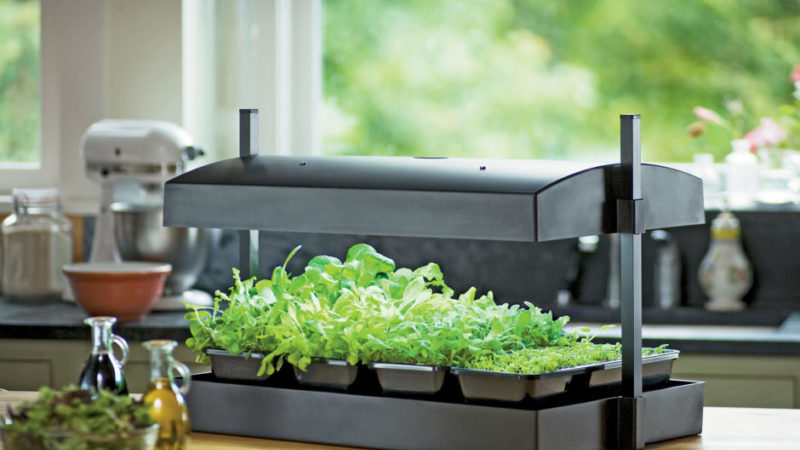
Manufacturers offer devices for every taste, wallet and request.
When choosing phytolamps, take into account:
- luminous flux in the PAR zone (photosynthetic active radiation) - the useful amount of light that hits the plant;
- type, cost, power;
- purpose (for seedlings, indoor flowers, greenhouses);
- economy, size, ease of installation;
- safety for people and plants.
Popular models
The rating of agrolamps was compiled on the basis of a thorough study of their characteristics, reviews of gardeners and expert opinions. The list includes only reliable, durable, safe and effective models.
Uniel 10 Watt
This is a small, full spectrum LED phytolamp. Its use guarantees normal photosynthesis and accelerates seedling growth. It is suitable for supplementary lighting of plants in apartments, in a small area. The lamp power is 10 W, the power consumption is very low. Cost - 550 rubles.
DNaZ "Reflax" 70 / G
70W sodium mirror lamp lasts up to 20,000 hours. Suitable for illuminating seedlings with an area of 1–1.5 m². With a 120 ° illumination angle, it gives an oval spot of light that completely covers the surface with plants. The continuous spectrum guarantees the growth and development of crops. Lamp price - 1000 rubles.
"Health treasure" at 16 W
The length of the phyto-light is 56 cm, the height is adjustable from 10 to 50 cm. The LED lamp is safe for plants and human eyes. Its spectrum contains only white, blue and red, which provides the correct lighting for the green part and the root system. By rotating around its axis, the lamp promotes better seedling growth and timely flowering. Cost - 2000 rubles.
"Bright Light Fito" WST-05
The popularity of this lamp is due to its bispectrality and different installation methods. The 35W LED bulb emits blue and red colors. It is installed on legs or suspended on a special mount. The device is used for seedlings and indoor flowers. It works equally well on windowsill and balcony. Price - 3000 rubles.
Reference. Good phytolamps are produced in Russia, China, the Netherlands.
How to make a phytolamp with your own hands
For those who want to save money, we suggest considering the option of making the device at home. For this you will need:
- LED strip in two colors (blue and red);
- power supply unit (charger from an old mobile phone will do);
- aluminum profile or plywood.
The tape is glued to a profile or a piece of plywood, suitable for the size of the window sill. Connect the power supply. Holes are made along the edges of the profile through which a strong rope, cord or wire is passed, and the structure is suspended at the desired height.
How to properly highlight seedlings
Additional lighting is required for plants throughout the entire growing period on the windowsill. Daylight hours are short for the full formation and development of shoots. In addition, 2/3 of autumn, winter and early spring, the weather is mostly cloudy, especially in northern latitudes. Natural light for seedlings is sorely lacking.
What time is it
Different plants require different day lengths. For example, tomatoes develop properly under light for at least 15-17 hours a day. Bell peppers and cucumbers are not so demanding - 13-14 hours are enough for them.
Helpful! Be sure to supplement the boxes with sown seeds - this way they hatch faster.
On average, plants need 8-10 hours of light per day, so from autumn to mid-spring the lamps are turned on for 4-6 hours. Before planting a new culture, they study its features of growth in nature. To achieve growth, flowering and fruiting, it is important to mimic natural conditions.
How to install on a windowsill
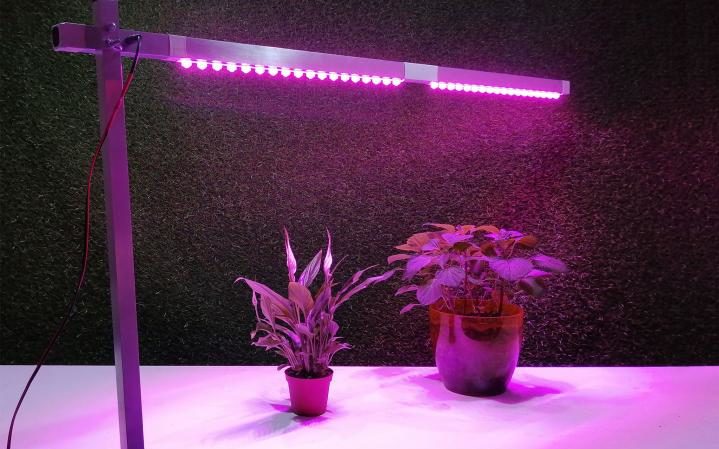
The preferred placement of phytolamps is in a suspended state with the ability to adjust the height as the seedlings grow. LED, luminescent, induction devices are placed from 10 to 30-40 cm above the soil surface. Incandescent or sodium lamps - no closer than 50 cm. Depending on the age of the plants, the height of the devices also changes.
To determine a safe height, a hand is held under the switched on lamp. If it's too warm, the plants will feel uncomfortable. In this case, the device is installed higher.
Conclusion
To obtain strong and healthy seedlings on the windowsill, from the very first days, it is watered, fed and supplemented. Without adequate lighting, plants stretch out, form weak, fragile and unviable. To bring maximum benefit and not harm the seedlings, use LED, sodium arc mirror, fluorescent or induction phytolamps. When placed at a suitable height, such devices do not burn the foliage, contribute to the correct course of photosynthesis and the formation of healthy seedlings.